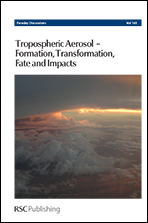How do organic vapors contribute to new-particle formation?
Abstract
Highly oxidised organic vapors can effectively stabilize sulphuric acid in heteronuclear clusters and drive new-particle formation. We present quantum chemical calculations of cluster stability, showing that multifunctional species can stabilize sulphuric acid and also present additional polar functional groups for subsequent cluster growth. We also model the multi-generation oxidation of vapors associated with secondary organic aerosol formation using a two-dimensional volatility basis set. The steady-state saturation ratios and absolute concentrations of extremely low volatility products are sufficient to drive new-particle formation with sulphuric acid at atmospherically relevant rates.
- This article is part of the themed collection: Tropospheric Aerosol – Formation, Transformation and Impacts

 Please wait while we load your content...
Please wait while we load your content...